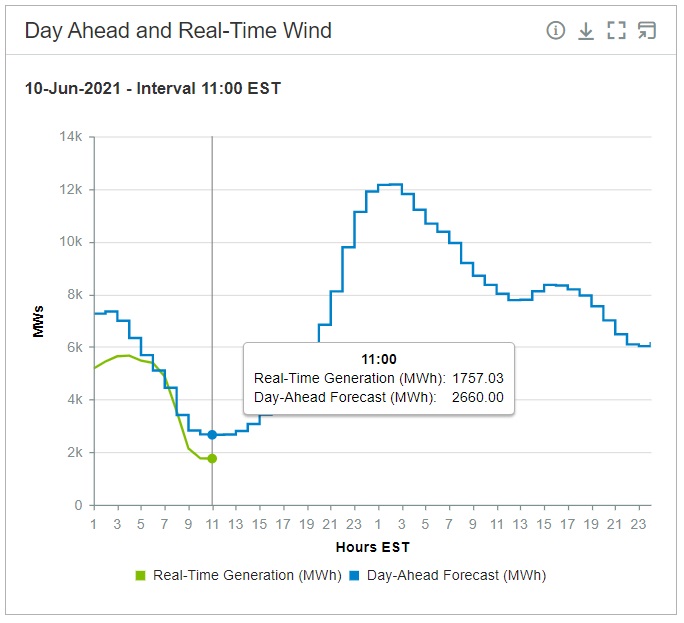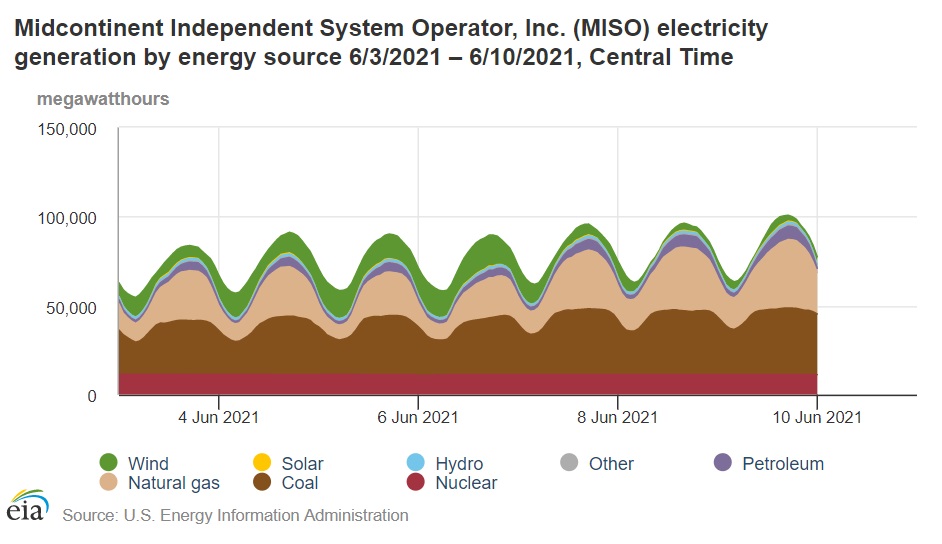Regional grid operator declares “maximum generation” warning —what does that mean?
The regional grid operator for Minnesota and 14 other states, the Midcontinent Independent Systems Operator (MISO), has declared a “Maximum Generation Emergency Warning” today due to unplanned outages, higher-than-normal temperatures, and electricity demand that is higher than expected.
Today, we’ll explain what that means, the underlying causes for the emergency warning, and what we can expect in the future.
What is a “Maximum Generation Emergency Warning?”
A “Maximum Generation Emergency Warning,” or “Max Gen” emergency warning, is a warning message to power plant operators that the supply of electricity on the grid is getting tight, and that they need all units on standby, ready to produce electricity when called upon.
In other words, it’s this iconic scene from Jurassic Park:
Low reserve margins
According to the MISO website, the reserve margin on June 8, 2021 was predicted to be 3.9 percent, which is below its 5 percent threshold. MISO has not updated us as to what the reserve margin is expected to be today, but given the fact that MISO declared a Max Gen emergency warning, we can assume that supplies are likely below the 5 percent threshold.
What is a reserve margin? In its most basic form, a reserve margin is a safety net for the grid of spare power plants that are available to generate electricity when supplies are tight.
For example, if MISO is expecting electricity demand to be 100 GW with a 5 percent reserve margin, that means grid would be capable of generating 105 GW of electricity during times of peak electricity demand. There would be a safety cushion of 5 GW in this scenario.
When supplies are tight, the grid operator calls upon reliable power plants that may be used infrequently, but they are vitally important to ensure there is enough electricity for everyone when it is needed most.
It’s not a dire situation
The supply of electricity on the regional grid is tight today, but the situation isn’t dire. We should be “ok” in terms of electricity supply as long as there aren’t any unforeseen power outages at a large power plant or transmission lines, assuming wind performs as it is expected to today.
Currently, most of the electricity being generated on the grid is coming from coal, natural gas and nuclear power. Solar is operating at a very high capacity, but electricity generation from wind turbines is low.

Wind turbines in MISO are generating 1,761 MW of electricity, out of a potential generation of 26,829 MW. In other words, wind turbines are producing 6.5 percent of their potential.
Thankfully, MISO isn’t depending on a lot of wind for reliability today. Instead, MISO’s reserve margin calculation smartly looks at the amount of wind generation 24 hours in advance for its planning purposes. This is called the “day ahead wind forecast,” which you can see below.

MISO expects the amount of electricity generated by wind turbines to fluctuate throughout the course of the next 24 hours. At 10 Central Time (11EST in the graph) wind was expected to generate 2,660 MW of electricity but, generated only 1,757 MW.
This is the estimated low point for wind over the next day, and the day-ahead forecast is usually very good from MISO. By about midnight central time, wind is expected to be generating about 12,000 MW, and as long as there isn’t a sudden drop off from wind, the situation should be ok.
“Load Modifying Resource”
MISO also has another trick up its sleeve if there is a problem at a large power plant, transmission line, or lower-than-expected output from wind turbines, which is to turn the power off on certain customers who have signed up for it.
This may seem strange, but it is more common than you might think. The ability to turn the power down, or off, on a customer is called a “Load Modifying Resource,” or LMR, in utility lingo. This could take the form of a lower electricity price for homeowners who volunteer to have their air conditioner or water heater turned off during times when the grid is stressed.
Businesses can also be considered LMRs if they have big diesel generators on site, and turn them on during periods where the supply of electricity on the grid is tight.
These programs can save customers money, but they can also be inconvenient. Hot days like today are the times when we want to use our air conditioners the most. Furthermore, if homeowners and businesses need an on-site backup generator — which can emit more pollutants than a coal plant — why are we shutting down our coal plants in the first place?
MISO is currently dipping into these LMR resources as part of their plan to keep the grid reliable, meaning the situation is getting more dire as electricity demand peaks.
Imports
Another tool in MISO’s toolbox are imports of electricity from neighboring regions. According to the MISO website, the grid operator expects imports to reach nearly 9,000 MW of electricity over the next 24 hours.

Much of this electricity comes from the regional grid called “PJM” in the east, and Manitoba and Ontario to the north.
Looking Ahead
Electricity supplies are tight, but MISO will probably be able to keep the lights on today. We may not be so lucky in the near future.
According to the North American Reliability Corporation (NERC):
Summer scenarios with high resource outages and high demand may require use of load modifying resources (LMRs) and non-firm imports during peak periods. LMRs are an increasingly important segment of MISO resource portfolio. Operators designate resource constrained periods (Maximum Generation Events) to access LMRs
MISO’s portfolio is becoming less reliable as utility companies seek to close down their existing coal, and even nuclear, power plants to build unreliable wind and solar. This is a bad idea, because wind has disappeared from the grid over the last three days. In fact, burning petroleum has generated more electricity than wind when we needed electricity the most.

The other concerning statement in the NERC report is their reference to “non-firm imports during peak periods.” This is exactly what California was relying on before rolling blackouts hit last summer because Arizona and Nevada didn’t have any power to spare. This is a very bad situation to be in.
Center of the American Experiment is very concerned about the direction our grid is headed, so we have taken the fight for electric reliability and affordability to the Minnesota Public Utilities Commission, and to MISO to make sure we have enough power when we need it most.